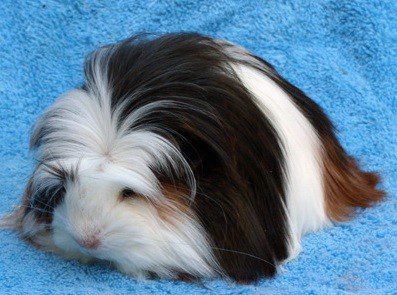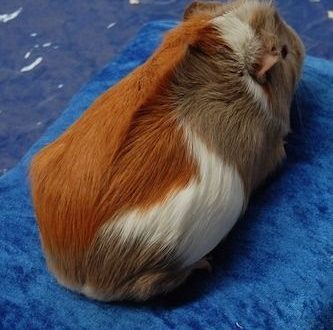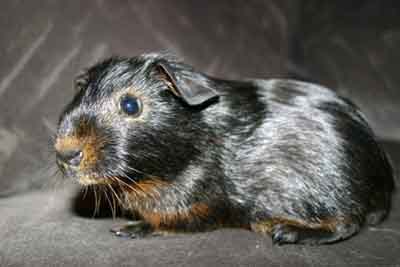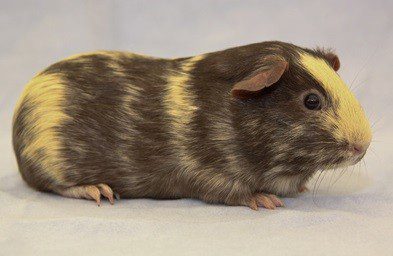
Magpies and harlequins
The line of my magpies, which I started to create even before I knew about ARBA / ACBA (American Rabbit Breeders Association / American Cavy Breeders Association), consists of a mixture of several breeds (different types of wool appear – short-haired, long-haired, teddy, long-haired teddy, crested, etc.).
I love magpies and work with them very seriously, and I also hope that they will soon become more popular and more acceptable for show and show (if it takes 10 or 20 years, well? Let it be So!).
Magpies and harlequins still do not have an official standard and belong to the group of rare breeds, so they are not accepted in many clubs. I use standards from other countries – Canada, Great Britain and Australia, where these breeds are successfully developed.
The line of my magpies, which I started to create even before I knew about ARBA / ACBA (American Rabbit Breeders Association / American Cavy Breeders Association), consists of a mixture of several breeds (different types of wool appear – short-haired, long-haired, teddy, long-haired teddy, crested, etc.).
I love magpies and work with them very seriously, and I also hope that they will soon become more popular and more acceptable for show and show (if it takes 10 or 20 years, well? Let it be So!).
Magpies and harlequins still do not have an official standard and belong to the group of rare breeds, so they are not accepted in many clubs. I use standards from other countries – Canada, Great Britain and Australia, where these breeds are successfully developed.

This is the English Standard Guide for Magpies (it does not have a scoring scale and can only be used in classes specifically designed for “rare breeds” gilts and is unacceptable for regular shows). Breeds and varieties that currently have only such a standard guideline may one day receive a full official standard, with significant support from breeders, an agreement to adopt this standard, and quality stock of lines. This breed is developing well in many countries, although in the USA it has not yet reached the same level.
This is the English Standard Guide for Magpies (it does not have a scoring scale and can only be used in classes specifically designed for “rare breeds” gilts and is unacceptable for regular shows). Breeds and varieties that currently have only such a standard guideline may one day receive a full official standard, with significant support from breeders, an agreement to adopt this standard, and quality stock of lines. This breed is developing well in many countries, although in the USA it has not yet reached the same level.
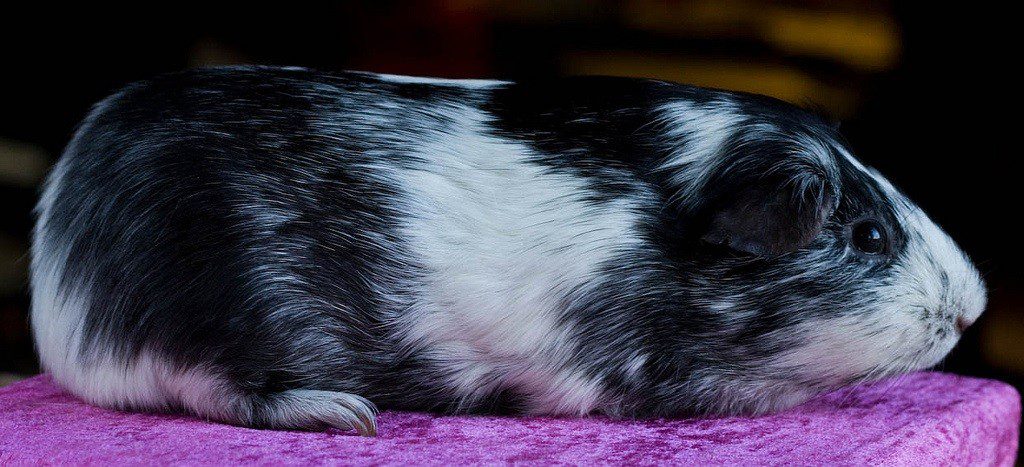
So, show standard for magpies and harlequins
Breed type: the bigger the better. The eyes are large, dark and round. The ears are large, well set and carried down.
Head: half black, half white, splitting down the center of the muzzle. The distribution of three colors on each side, the same ratio of black, white and black and white. Straight line at top and bottom. The marks are the same size.
Colors, recognized as the standard guide in England: black magpies – a mixture of black, white and black and white. Brown magpies are a mixture of brown, white and brown-white.
Disadvantages: the presence of color belts (belting), the absence of any color on one of the sides.
Serious disadvantages: completely unpainted one side.
Disqualifying faults: third eyelid, violations of the coat and skin, withers.
A similar standard exists for harlequins, where white is replaced by yellow.
The following nuances are not considered in the standard, but when discussing this breed with foreign breeders, the following remarks were made:
Some experts prefer contrastingly colored paw pads. According to the breeders I spoke with, this paw color is not exactly mentioned in the standard, and therefore should not be given too much importance, but this contrasting paw color is most preferable.
So, show standard for magpies and harlequins
Breed type: the bigger the better. The eyes are large, dark and round. The ears are large, well set and carried down.
Head: half black, half white, splitting down the center of the muzzle. The distribution of three colors on each side, the same ratio of black, white and black and white. Straight line at top and bottom. The marks are the same size.
Colors, recognized as the standard guide in England: black magpies – a mixture of black, white and black and white. Brown magpies are a mixture of brown, white and brown-white.
Disadvantages: the presence of color belts (belting), the absence of any color on one of the sides.
Serious disadvantages: completely unpainted one side.
Disqualifying faults: third eyelid, violations of the coat and skin, withers.
A similar standard exists for harlequins, where white is replaced by yellow.
The following nuances are not considered in the standard, but when discussing this breed with foreign breeders, the following remarks were made:
Some experts prefer contrastingly colored paw pads. According to the breeders I spoke with, this paw color is not exactly mentioned in the standard, and therefore should not be given too much importance, but this contrasting paw color is most preferable.
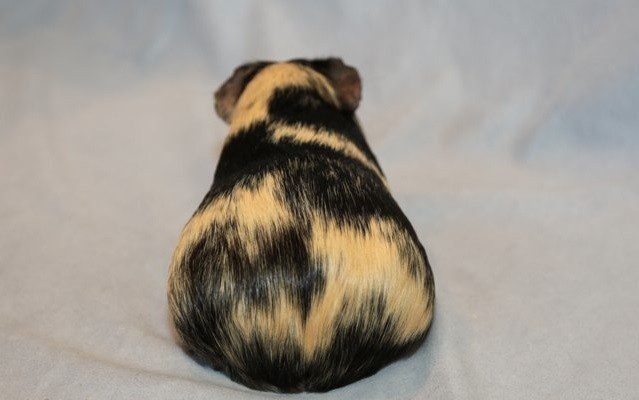
The standard does not say anything about the quality of wool – smooth-haired pigs should have a short silky coat. Other varieties of gilts must meet their standards for wool quality. However, as an emerging breed, Magpies and Harlequins are most often shorthaired – American Cresteds are the most common, but so are Rexes, Teddies, and English Cresteds (not accepted in the US) are also relatively common. In long-haired pigs, this color cannot be shown to the proper extent.
For those new to the terminology, ‘collar’ is something that is often found in coloration in mice. They have just this is the ideal color distribution, the accepted standard. In essence, a belt is a stripe of one color, running continuously from one side, through the back, to the other side. Such zonation is undesirable in either magpies or harlequins. There should be a dividing center line between the flowers, running along the head, back, belly and ending at the chest and chin.
Eye color, especially in magpies and especially on the white side of the muzzle, will be ruby rather than dark.
Here are some samples from my gilts. These are not the best representatives, as I started work relatively recently, so they still require a lot of work. In my opinion. As my acquaintances breeders from other countries, who also deal with rare breeds, told me, I’m doing well. In any case, the presented photographs reflect the main features of the breed quite well.
A.Gangi (by A.Gangi)
© Translation by Alexandra Belousova
The standard does not say anything about the quality of wool – smooth-haired pigs should have a short silky coat. Other varieties of gilts must meet their standards for wool quality. However, as an emerging breed, Magpies and Harlequins are most often shorthaired – American Cresteds are the most common, but so are Rexes, Teddies, and English Cresteds (not accepted in the US) are also relatively common. In long-haired pigs, this color cannot be shown to the proper extent.
For those new to the terminology, ‘collar’ is something that is often found in coloration in mice. They have just this is the ideal color distribution, the accepted standard. In essence, a belt is a stripe of one color, running continuously from one side, through the back, to the other side. Such zonation is undesirable in either magpies or harlequins. There should be a dividing center line between the flowers, running along the head, back, belly and ending at the chest and chin.
Eye color, especially in magpies and especially on the white side of the muzzle, will be ruby rather than dark.
Here are some samples from my gilts. These are not the best representatives, as I started work relatively recently, so they still require a lot of work. In my opinion. As my acquaintances breeders from other countries, who also deal with rare breeds, told me, I’m doing well. In any case, the presented photographs reflect the main features of the breed quite well.
A.Gangi (by A.Gangi)
© Translation by Alexandra Belousova



